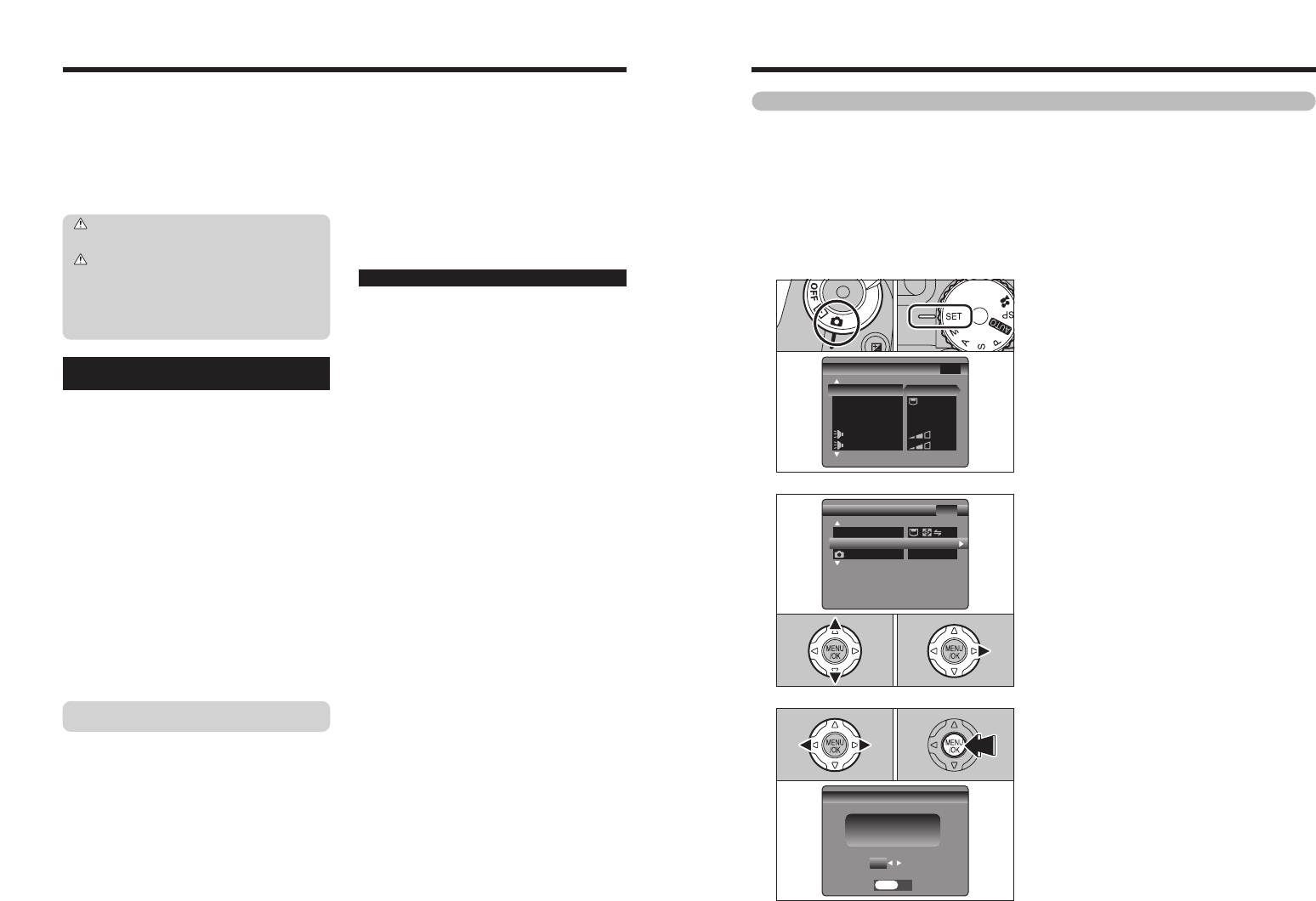
108 109
The “Discharging rechargeable batteries” function can only be used with Ni-MH
batteries.
The “Discharging rechargeable batteries” function should not be used with
alkaline batteries as it will completely drain the battery charge.
Use the “Discharging rechargeable batteries” function in the following situations:
i When the batteries can only be used for a short time after being charged normally
i When the batteries have not been used for a long period
i When you purchase new Ni-MH batteries
Do not use the “Discharging rechargeable batteries” function while using the AC power adapter. In
these situations, the Ni-MH batteries will not be discharged due to the external power supply.
Procedure for discharging rechargeable Ni-MH batteries
1
1Set Power switch to “q”.
2Set the Mode dial to “W” to display the SET-UP
menu.
01 02
●
!
Do not use the procedure for discharging rechargeable
batteries with alkaline batteries.
2
1Press “a” or “b” to select “DISCHARGE”.
2Press “c”.
01 02
3
1Press “d” or “c” to select “OK”.
2Press the “MENU/OK” button.
The screen changes and discharging begins.
When the battery level indicator blinks red and
discharging ends, the camera turns off.
01 02
●
!
To cancel discharging, press the “BACK” button.
Notes on the Power Supply
Always use the AC Power Adapter AC-5VH/AC-5VHS
with the camera.
The use of an AC power adapter other than AC-5VH/
AC-5VHS could result in damage to your digital
camera.
h This AC power adapter is designed exclusively for
indoor use.
h Plug the connection cord plug securely into the DC
input terminal of the FUJIFILM Digital camera.
h Turn off the FUJIFILM Digital camera before
disconnecting the connection cord from the
FUJIFILM Digital camera’s DC input terminal. To
disconnect, take hold of the plug and pull it out (do
not disconnect it by pulling on the cord).
h Do not use this AC power adapter with any device
except the specified device.
h During use, this AC power adapter will become hot
to the touch, but this is normal.
h Do not disassemble the AC power adapter. Doing so
could be dangerous.
h Do not use this device in a place with high
temperature and high humidity.
h Do not drop or subject this device to strong shocks.
h This device may emit a humming noise, but this is
normal.
h If used near a radio, this device may cause static, so
play the radio in a distant place.
AC Power Adapter
Notes on using the AA-size Ni-MH
batteries correctly
This is particularly true of alkaline batteries. In cold
conditions, put the batteries in your pocket or a
similar place to warm them before loading them into
the camera. If you use a body warmer to warm the
batteries, ensure that they are not in direct contact
with the warmer.
h Soil (such as fingerprints) on the battery terminals
can markedly reduce the number of available
frames. Carefully wipe the battery terminals clean
with a soft dry cloth before loading the batteries.
If any liquid at all leaks from the batteries, wipe
the battery compartment thoroughly and then
load new batteries.
If any battery fluid comes into contact with your
hands or clothing, flush the area thoroughly
with water. Note that battery fluid can cause
loss of eyesight if it gets into your eyes. If this
occurs, do not rub your eyes. Flush the fluid
out with clean water and contact your physician
for treatment.
h As a power source in digital cameras, AA-size Ni-
MH batteries are superior to alkaline batteries in
several ways, such as allowing more shots to be
taken with the camera. However, care must be taken
with the way Ni-MH batteries are used if their
original performance is to be maintained.
h Ni-MH batteries left unused in storage for long
periods can become “deactivated”. Also, repeatedly
charging Ni-MH batteries that are only partially
discharged can cause them to suffer from the
“memory effect”.
Ni-MH batteries that are “deactivated” or affected by
“memory” suffer from the problem of only providing
power for a short time after being charged. To
prevent this problem, discharge and recharge them
several times using the camera’s “Discharging
rechargeable batteries” function. By repeating this
cycle several times, the temporary reduction in
performance caused by “memory” or “deactivation”
can be remedied and the batteries can be restored
to their original performance levels.
Deactivation and memory are specific to Ni-MH
batteries and are not in fact battery faults. See P.109
for the procedure for “Discharging rechargeable
batteries”
Do not use the “Discharging rechargeable batteries”
function when alkaline batteries are being used.
h To charge Ni-MH batteries, use the quick battery
charger (sold separately). Refer to the instructions
supplied with the charger to ensure that the charger
is used correctly.
h Do not use the battery charger to charge batteries
other than those specified for use with the charger.
h Note that the batteries may feel warm immediately
after being charged.
h Due to the way the camera is constructed, a small
amount of current is used even when the camera is
turned off. Note in particular that leaving Ni-MH
batteries in the camera for a long period will
overdischarge the batteries and may render them
unusable even after recharging.
h Ni-MH batteries will self-discharge even when not
used, and the time for which they can be used may
be shortened as a result.
h Ni-MH batteries will deteriorate rapidly if
overdischarged (eg. by discharging the batteries in a
flashlight). Use the "Discharging rechargeable
batteries" function provided in the camera to
discharge the batteries.
h Ni-MH batteries have a limited service life. If a
battery can only be used for a short time even after
repeated discharge-charge cycles, it may have
reached the end of its service life.
■ Disposing of Batteries
When disposing of batteries, do so in accordance with
your local waste disposal regulations.


















